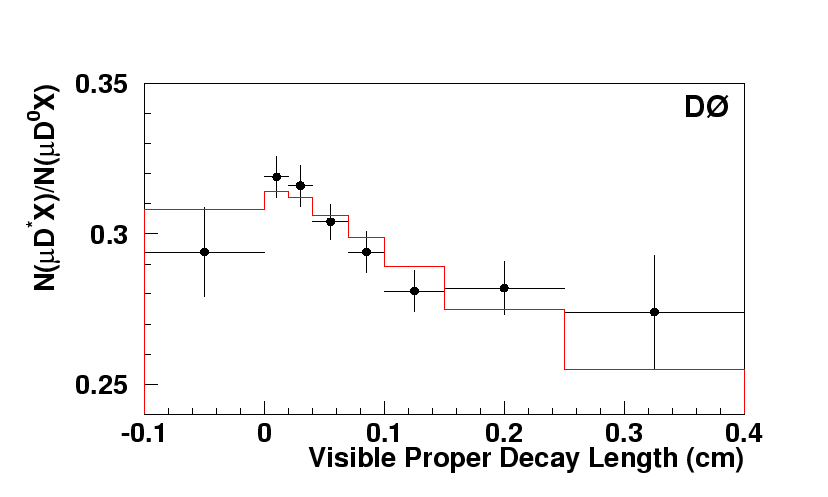Life expectancy was supposed to be the same for neutral and charged B mesons - it turned out not to be true as showed a recent precise measurement performed at the DZero detector at Fermilab. The lifetime of these mesons differs by eight percent, about by how much women live longer than men.
Neutral and charged B mesons have a lot of things in common. As all mesons they are composed of a quark-antiquark pair. One quark is always a "bottom" quark, the second heaviest of all existing quarks. The other partner is a light quark, either of "up" or "down" type. The two quarks, heavy and light, share their responsibilities for the properties of B mesons. Heavy quark cannot easily disintegrate and this determines the long lifetime of the mesons. For nuclear time scales this lifetime is amazingly long, 1.5 ps (one-trillionth of a second) and, in fact, B mesons hold a record among other particles in the same weight category. Though long for high energy physics scale, one and a half ps is about enough time for light to pass only half a millimeter.
The light quark determines if the B meson is neutral or charged - also an impotant property. A (b - anti-u) pair forms a charged B meson and a (b - anti-d) pair forms a neutral B meson. This fact is simple to understand because the charge of b quark is -1/3 and charge of anti-d is 1/3 so there sum is 0. Similarly a combination of b and anti-u quarks has charge (-1/3) + (-2/3) = -1. For a long time it was assumed that the light quark, which is stable, plays only a "spectator" role in the disintegration of the heavy partner. However, it turns out the life expectancy does depend on who is your partner and exchanges between heavy and light quarks matter. Initial theoretical calculations showed that the lifetimes should be different by several percent. Recent progress in the theory allowed us to determine all contributions to the lifetime calculations with more precision than previously possible and predict the ratio of these lifetimes at 1.06 +- 0.02. Thus, the theory sais that charged B meson lives longer than neutral B meson by approximately 6 percent. It is very important now to improve the precision of experimental measurements in order to test the theoretical assumptions used in the calculations. In Run II, the DZero experiment has collected a large sample of B- and B0 decays and has made a precision measurement of this difference using decays of B mesons to a muon, its neutrino and a D meson as explained in more detail below.
Physicists at Fermilab have a long history of studying B mesons at the Tevatron collider. These mesons are abundantly produced in the proton-antiproton collisions and experiments use complicated trigger algorithms and electronics to select those events out of billions of other collisions. At the analysis phase B mesons are reconstructed combining a muon and two or three other particles. Muons are very similar in properties to electrons but they are about 200 times heavier. Experimentalists like muons because they do not interact much with matter and reach the outmost part of the detector penetrating through thick slabs of iron. This allows for easy identification of the muons. The other particles in the same event have to form D mesons and the exact type of D meson indicates the charge of the parent B meson. D mesons are composed of a "charm" quark and a light anti-quark. These mesons can be reconstructed as peaks in the invariant mass distributions as shown in the figures below. If two particles, kaon and pion, tend to originate from something that weighs like a D0 meson with mass about 1.86 GeV (left plot) then with high probability their parent B meson was charged. However is some cases there could be another pion which forms a D*+ meson together with the two first particles. We can identify these cases looking at the mass difference between the kaon-pion mass and kaon-pion-pion mass (right plot). If this is true and these kaon and two pions form a D*+ peak then with high probability their parent B meson was neutral.


We split these D0 and D* samples into intervals of time and measure the ratio of lifetimes by taking the ratio of the number of D0 and D*+ events in each interval. This ratio is shown at the plot below. The variable "Visible Proper Decay Length" used for this plot is closely related to the lifetime that we want to measure. If the lifetimes of charged and neutral B mesons were the same, the data points in the below histogram would fall on a flat line. We see that this is not the case - the number of neutral B mesons decreases faster than the number of charged mesons with time and this proves that the lifetimes are different. We use a refined mathematical procedure that takes into account many other experimental and theoretical inputs and their uncertainties to extract the exact value of the lifetime ratio from this graph below.

Our result submitted for publication in Phys.Rev.Letters in October 2004, R = 1.080 +- 0.016 (stat) +- 0.014 (sys), agrees with previous results, and the precision of our measurement is better than the previously published single best measurements from the Belle experiment at KEK and BaBar experiment at SLAC. The new result of DZero is also in good agreement with the latest theoretical prediction.
The preliminary result of this analysis made headlines in the "Fermilab Today" daily newsletter in April 2004.
http://www.fnal.gov/pub/today/archive_2004/today04-04-29.html
The full text of the submitted publication can be found at the link below.
http://arxiv.org/abs/hep-ex/0410052
Please address your further inquires to the primary authors : Guennadi Borissov, Sergey Burdin, Andrei Nomerotski.